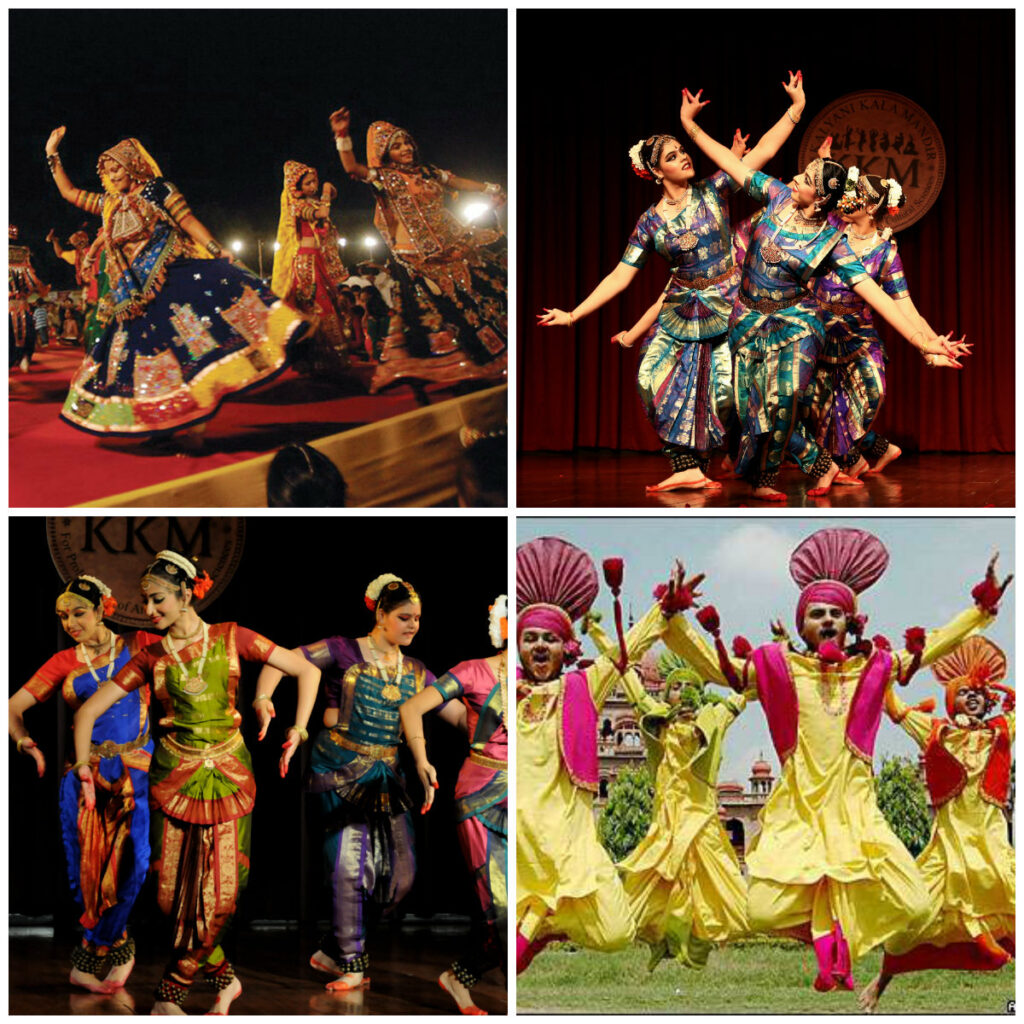Classical Dances of India
From the 12th century until the 19th century, musical plays known as sangeet-nataka developed into contemporary Classical Dances styles.


Tandava movement and rhythm and Lasya dancing are the two main elements of Indian classical dance grace, bhava & rasa.
Bharatanatyam
Bharatnatyam is a cultural Indian dance originating from Tamil Nadu
Nandikesvara’s Abhinaya Darpana is one of the most important texts for studying the skill and language of physical movements in Bharatnatyam Dance. Bharatnatyam is a dance classification wherein a solitary craftsman addresses many characters in a solitary appearance. Transitional leg, hip, and arm motions are used in the dance.
Dramatic eye movements plus hand movements is an essential skill. A vocalist, mridangam artist, violinist player, flutist, and cymbal player make up the accompanying ensemble. The Nattuvanar is the one who directs the dancing recital. On the gopurams of the Chidambaram temple, Bharatnatyam positions are represented.
Kathak
Kathak is a popular genre of old Indian dance that is claimed to have originated with North Indian voyaging versifiers designated as Kathakars or narrators. These Kathakars wandered around narrating legends with song, dance, and melodies, much like the early Greek theatre. spiritual improvement is an otherworldly reflection inclination that arose in archaic Hinduism.
The Kathakars use rhythmic foot motions, hand gestures, facial expressions, and eye work to tell stories. This work of art, which combines stories from ancient history and key events in Lord Krishna’s life, proved extremely famous in the palaces of North Indian monarchs.
Kathakali
Kerala’s sacred performance arts such as Chakiarkoothu, Koodiyattam, Krishnattam, and Ramanattam impacted and shaped Kathakali’s skill. Kathakali is a dramatization of stories drawn from Indian epics that combines movement and drama. There is a lot of make-up and appropriate attire.
The actors play the roles of emperors, divinities, demons, and other figures from the tales. Specific face tones show different looks and qualities, similar to green for fairness, dull for mischievousness, and red patches for the government. essentials include hand motions, facial reactions, and eye gaze.
Kuchipudi
Andhra Pradesh, in India, is where this antiquated type of Indian dance started.
Siddhendra Yogi, a talented Vaishnava writer, made the ongoing Kuchipudi style in the seventeenth-century period. It arose from a long and rich heritage of singing and dancing of the same name in the 3rd and 4th decades of the twentieth century. It has its origins in Yakshagana as well.
Kuchipudi arose from a Hindu god Krishna-centered Vaishnav heritage, and it is strongly connected with the Bhagavata Mela. Besides dancing and performing, a Kuchipudi practitioner must be skillfully fluent in Sanskrit and Telugu, as well as musical and stage oral histories.
Mohini attam
Mohiniyattam, a manifestation of Lord Vishnu, is the old-style solo dance type of Kerala.
Mohiniyattam is mentioned in the books Vyavaharamala by Mazhamagalam Narayanan Namputiri, published in 1709, and Ghoshayatra by poet Kunjan Nambiar published later.
It is roused by Bharatanatyam and Kathakali, and it is integrated into this dance structure.
Manipravala is a historic south Indian dialect that integrates Tamil, Malayalam, and Sanskrit.
The Vyavaharamala, penned around 1709 by Mazhamagalam Narayanan Namputiri, and Ghoshayatra, produced subsequently by artist Kunjan Nambiar, both include connections to Mohiniyattam.
Odissi
The significant subjects of execution are legends of manifestations of Lord Vishnu and sections of Jayadeva’s Gita Govinda.
A delicate dance upheld by calming verses and it is like Bharatanatyam concerning the mudras and articulations.
Sattriya
Sankaradeva, a Vaishnava divine person and Assamese pioneer, presented the Sattriya dance structure in the fifteenth century A.D. as a pathway for propagating Vaishnava beliefs.
Sattriya is the term given to this folk dance because of its disciplined personality and association with the Sattras Vaishnava religious organizations.
Manipuri
Manipuri art is one of the national leading traditional dance styles, noted for form factors on Lord Vishnu and dramatic performances of ‘Ras Lila’, dance plays centered upon Radha with Krishna’s affection. Rasleela performances are existing prevalent since the 18th century.
A distinct combination of Indian and Southeast Asian cultures may indeed be found there.
Throughout Manipur, the Kirtan form of communal singing is referred to as Sankirtana.
The Manipuris play out this strict craftsmanship that targets communicating otherworldly qualities during Hindu celebrations and other significant social events like marriage.
